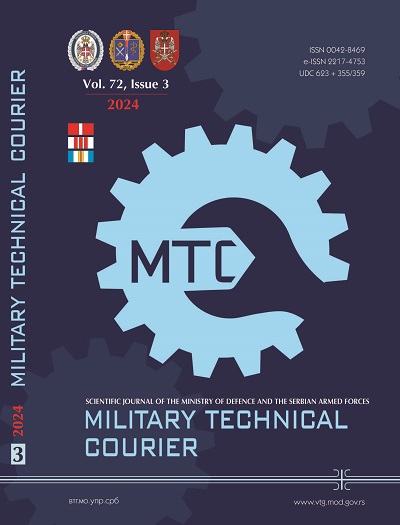Distinct features and validation of δ⋇-algebras: an analytical exploration
Abstract
Introduction/purpose: This research introduces the concept of a δ⋇- algebra, a unique structure in the field of abstract algebra. The study aims to explore the defining features and distinct properties of δ⋇-algebras, distinguishing them from other algebraic systems and examining their interrelations with other types of algebras.
Methods: The methodology includes the formal definition and characterization of δ⋇-algebras, a comparative analysis with the existing algebraic structures, and an exploration of their interconnections. An algorithm is developed to verify whether a given structure meets the conditions of a δ⋇-algebra.
Results: The results reveal that δ⋇-algebras possess unique properties not found in other algebraic systems. The comparative study clarifies their distinctive place within the algebraic landscape and highlights significant interrelations with other structures. The verification algorithm proves effective in identifying δ⋇-algebras, providing a systematic approach for further study.
Conclusions: In conclusion, δ⋇-algebras represent a significant addition to abstract algebra, offering new theoretical insights and potential for future research. The study’s findings enhance the understanding of algebraic systems and their interconnections, opening new avenues for exploration in the field.
References
Ahn, S.S. & Kim, H.S. 1999. On QS-algebras. Journal of the Chungcheong Mathematical Society, 12(1), pp.33-41 [online]. Available at: https://koreascience.kr/article/JAKO199917069750921.page [Accessed: 15 May 2024].
Ahn, S.S. & Han, J.S. 2013 On BP-Algebras. Hacettepe Journal of Mathematics and Statistics, 42(5), pp.551-557 [online]. Available at: https://dergipark.org.tr/en/pub/hujms/issue/7746/101253 [Accessed: 15 May 2024].
Akram, M. & Kim, H.S. 2007. On K-algebras and BCI-algebras. International Mathematical Forum, 2(9-12), pp.583-587. Available at: https://doi.org/10.12988/imf.2007.07054.
Chandramouleeswaran, M., Muralikrishna, P., Sujatha, K. & Sabarinathan, S. 2017. A note on Z-algebra. Italian Journal of Pure and Applied Mathematics, 38, pp.707-714 [online]. Available at: https://ijpam.uniud.it/online_issue/201738/61- Chandramouleeswaran-Muralikrishna-Sujatha-Sabarinathan.pdf [Accessed: 15 May 2024].
Iséki, K., Kim, H.S. & Neggers, J. 2006. On J-algebras. Scientiae Mathematicae Japonicae, 63(3), pp.413-420 [online]. Available at: https://www.jams.or.jp/scm/contents/e-2006-3/2006-30.pdf [Accessed: 15 May 2024].
Iséki, K. & Tanaka, S. 1978. An introduction to the theory of BCK-algebras. Mathematica Japonica, 23(1), pp.1-26.
Jun, Y.B., Roh, E.H. & Kim, H.S. 1998. On BH-Algebras. Scientiae Mathemat- icae, 1(3), pp.347-354 [online]. Available at: https://www.jams.jp/scm/contents/Vol-1-3/1-3-12.pdf. [Accessed: 15 May 2024].
Kaviyarasu, M., Indhira, K. & Chandrasekaran, V.M. 2017. Introduction on INK- Algebras.International Journal of Pure and Applied Mathematics, 115(9), pp.1-9 [online]. Available at: https://acadpubl.eu/jsi/2017-115-9/articles/9/1.pdf [Ac- cessed: 15 May 2024].
Kim, C.B. & Kim, H.S. 2006. On BM-algebras. Scientiae Mathematicae Japo- nicae, 63(3), pp.215-221 [online]. Available at: https://www.jams.or.jp/scm/contents/e-2006-3/2006-22.pdf [Accessed: 15 May 2024].
Kim, C.B. & Kim, H.S. 2008. On BG-algebras. Demonstratio Mathematica, 41(3), pp.497-506. Available at: https://doi.org/10.1515/dema-2008-0303.
Kim, C.B. & Kim, H.S. 2012. On BO-algebras. Mathematica Slovaca, 62(5), pp.855-864. Available at: https://doi.org/10.2478/s12175-012-0050-9.
Kim, H.S. & Kim, Y.H. 2006. On BE-algebras. Scientiae Mathematicae Japo- nicae, 66(1), pp.1299-1302 [online]. Available at: https://www.jams.jp/scm/contents/e-2006-12/2006-120.pdf. [Accessed: 15 May 2024].
Kim, Y.H. & So, K.S. 2012. β-algebras and related topics.Communications of the Korean Mathematical Society, 27(2), pp.217-222. Available at: https://doi.org/10.4134/CKMS.2012.27.2.217.
Megalai, K. & Tamilarasi, A. 2010. TM-algebra - An Introduction. IJCA Special Issue on “Computer Aided Soft Computing Techniques for Imaging and Biomedical Applications” CASCT, pp.17-23. Available at: https://doi.org/10.5120/996-29.
Meng, B.L. 2010. CI-algebras. Scientiae Mathematicae Japonicae, 71(1), pp.11-17. Available at: https://doi.org/10.32219/isms.71.1_11.
Neggers, J. & Kim, H.S. 1999. On d-algebras. Mathematica Slovaca, 49(1), pp.19-26 [online]. Available at: http://dml.cz/dmlcz/129981 [Accessed: 15 May 2024].
Neggers, J. & Kim, H.S. 2002a. On B-algebras. Matematički vesnik, 54(1-2), pp.21-29 [online]. Available at: https://scindeks.ceon.rs/article.aspx?artid=0025-51650202021N [Accessed: 15 May 2024].
Neggers, J. & Kim, H.S. 2002b. On β-algebras. Mathematica slovaca, 52(5), pp.517-530 [online]. Available at: http://dml.cz/dmlcz/131570 [Accessed: 15 May 2024].
Walendziak, A. 2007. On BF-algebras. Mathematica Slovaca, 57(2), pp.119-128. Available at: https://doi.org/10.2478/s12175-007-0003-x.
Copyright (c) 2024 Muralikrishna Prakasam, Hemavathi Perumal, Vinodkumar Raja, Chanthini Perumal, Palanivel Kaliyaperumal, Edalatpanah Seyyed Ahmad

This work is licensed under a Creative Commons Attribution 4.0 International License.
Proposed Creative Commons Copyright Notices
Proposed Policy for Military Technical Courier (Journals That Offer Open Access)
Authors who publish with this journal agree to the following terms:
Authors retain copyright and grant the journal right of first publication with the work simultaneously licensed under a Creative Commons Attribution License that allows others to share the work with an acknowledgement of the work's authorship and initial publication in this journal.
- Authors are able to enter into separate, additional contractual arrangements for the non-exclusive distribution of the journal's published version of the work (e.g., post it to an institutional repository or publish it in a book), with an acknowledgement of its initial publication in this journal.
- Authors are permitted and encouraged to post their work online (e.g., in institutional repositories or on their website) prior to and during the submission process, as it can lead to productive exchanges, as well as earlier and greater citation of published work (See The Effect of Open Access).

